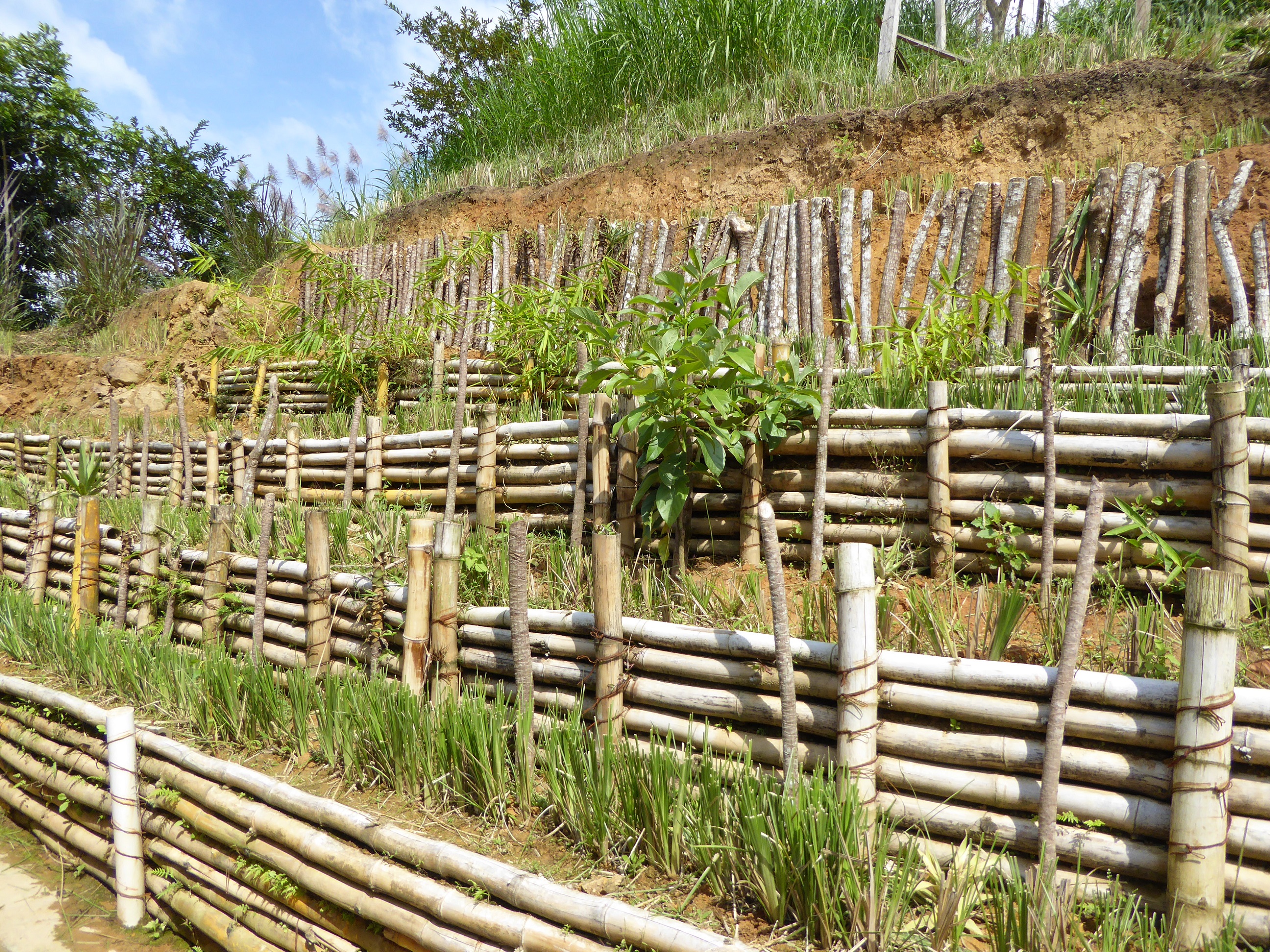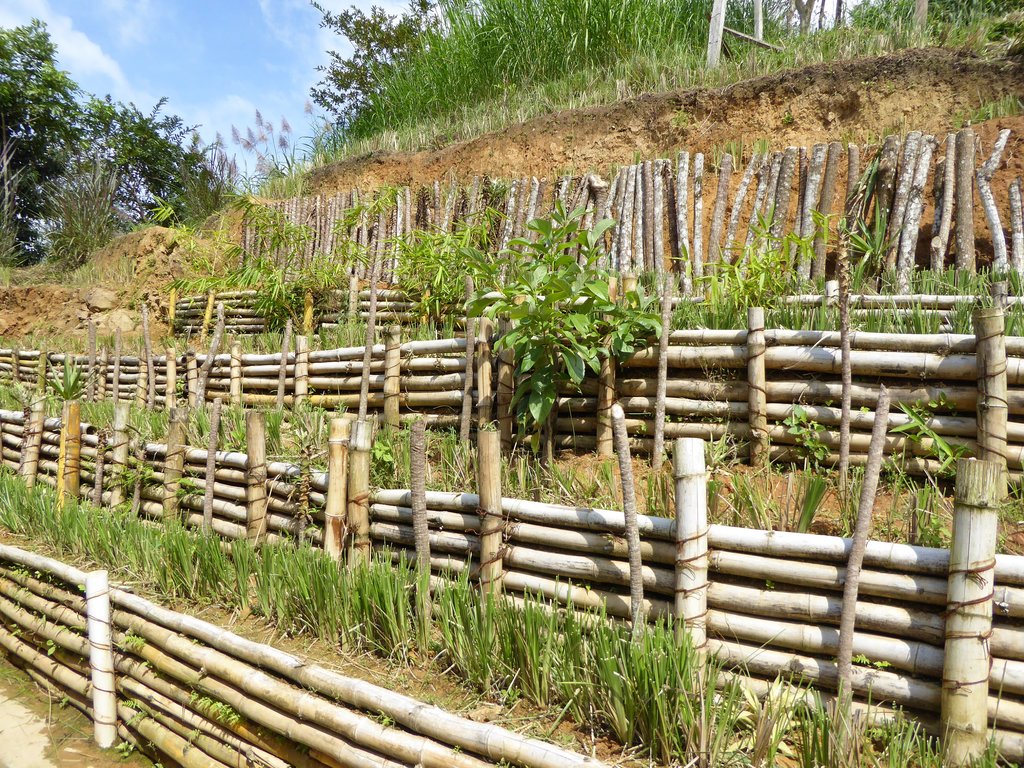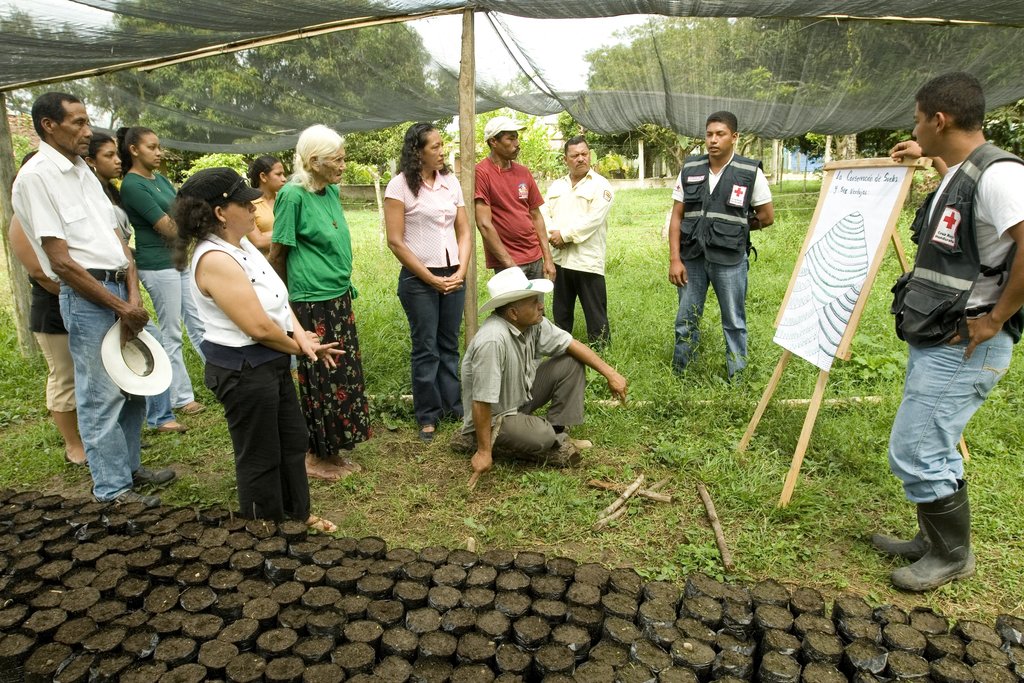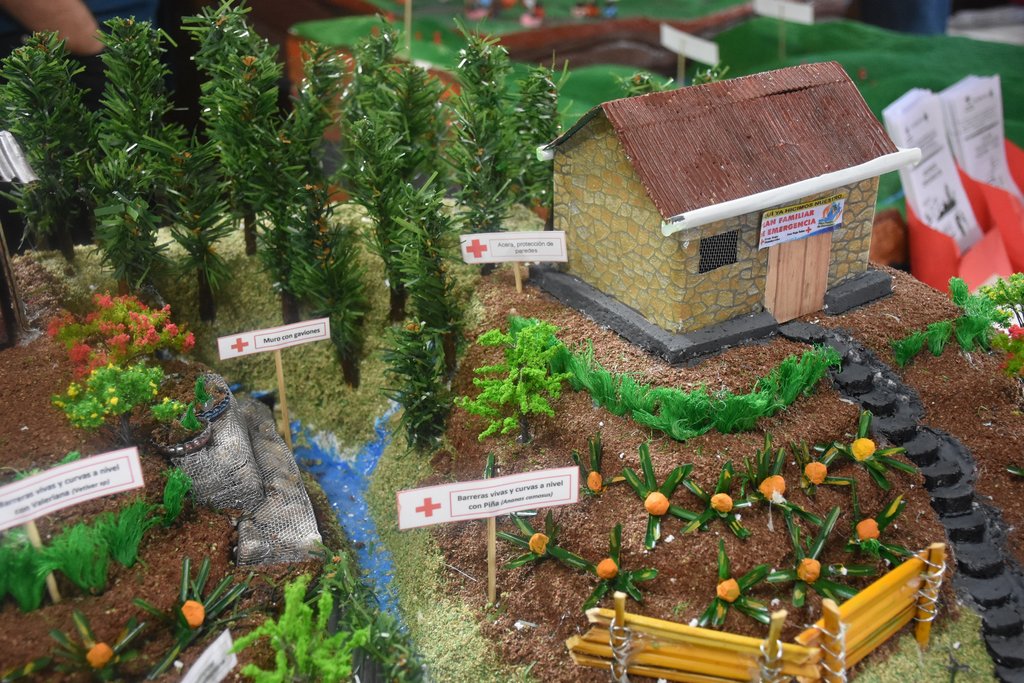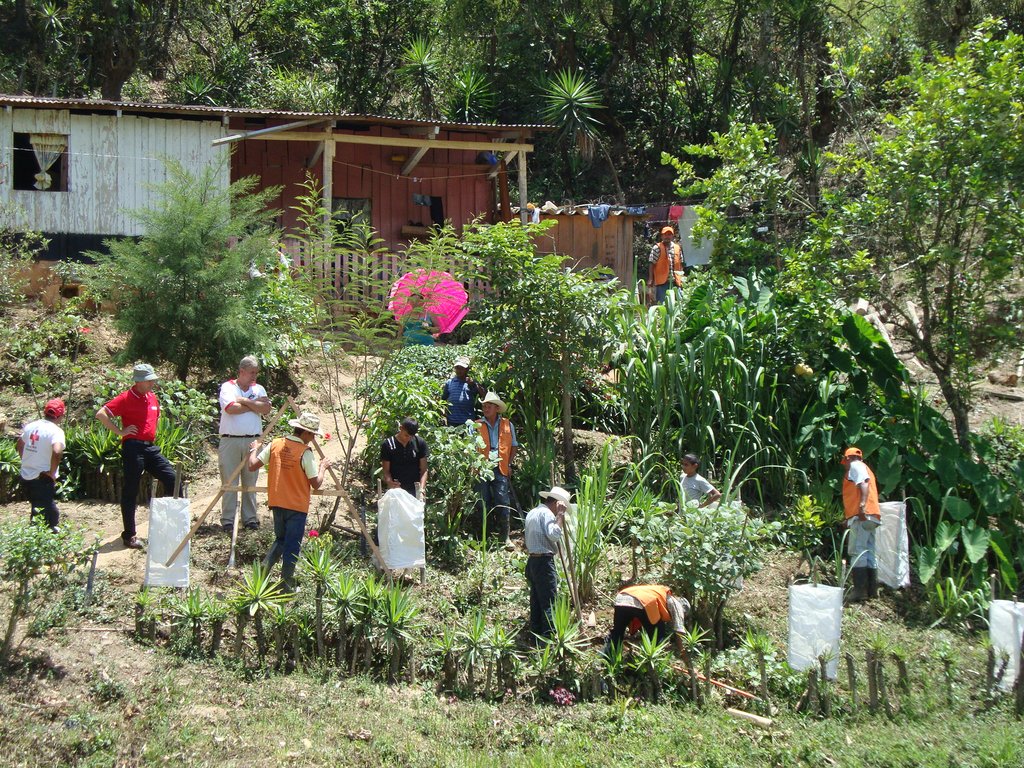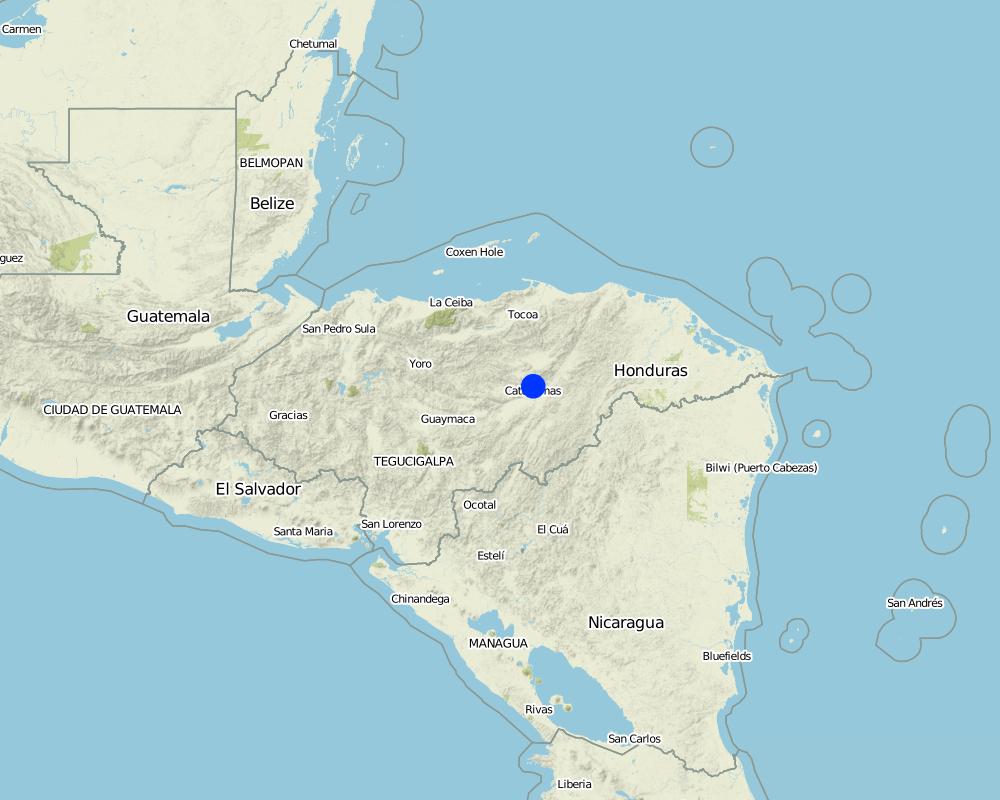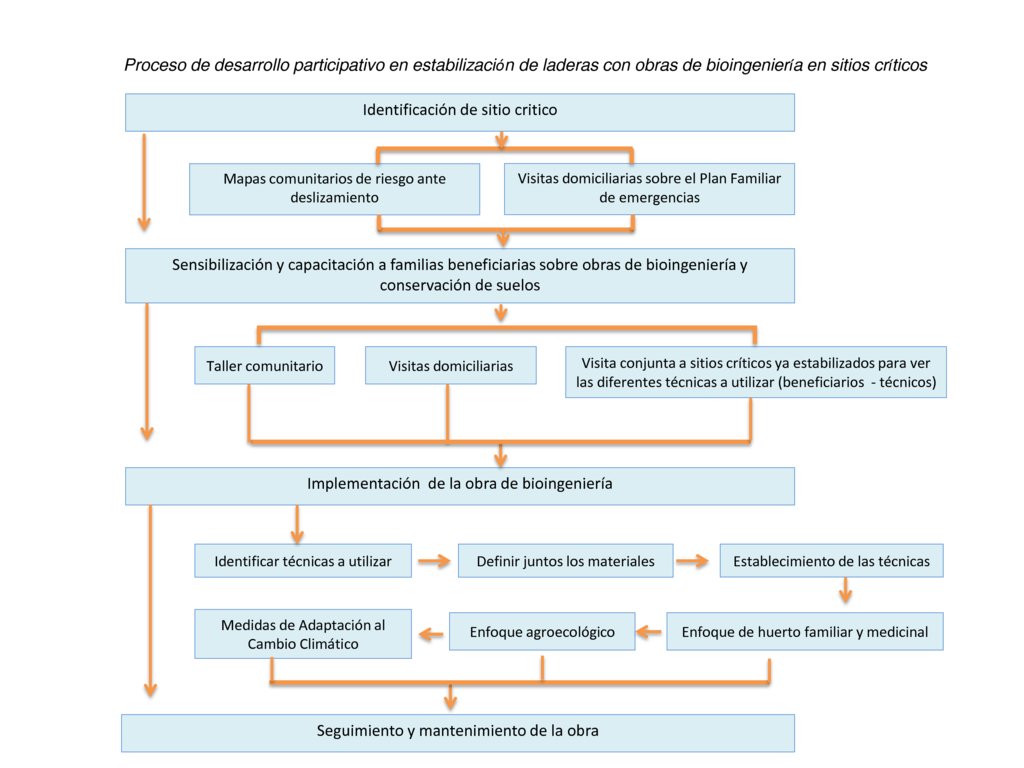Participative Slope Stabilization [Honduras]
- Creation:
- Update:
- Compiler: Helen Gambon
- Editors: Helen Gambon, Anton Jöhr
- Reviewers: Johanna Jacobi, Alexandra Gavilano
Bioingeniería
approaches_745 - Honduras
View sections
Expand all Collapse all1. General information
1.2 Contact details of resource persons and institutions involved in the assessment and documentation of the Approach
Key resource person(s)
SLM specialist:
Paguada Carmen
claudio.stauffer@redcross.ch / gregoire.labhardt@redcross.ch
Honduran/ Swiss Red Cross
In Honduras: Swiss Red Cross Office, Catacamas. Contact: Claudio Stauffer, Country coordinator In Switzerland: Swiss Red Cross, Werkstrasse 18, 3084 Wabern. Contact: Grégoire Labhardt, Head of program
Honduras
SLM specialist:
Montes Lobo Carlos
claudio.stauffer@redcross.ch / gregoire.labhardt@redcross.ch
Honduran/ Swiss Red Cross
In Honduras: Swiss Red Cross Office, Catacamas. Contact: Claudio Stauffer, Country coordinator In Switzerland: Swiss Red Cross, Werkstrasse 18, 3084 Wabern. Contact: Grégoire Labhardt, Head of program
Honduras
land user:
Isaias Guillén José
Key reference people for the Technologies related to the approach: communities of La Felicidad, Nueva Esperanza and Río Blanco, Dulce Nombre de Culmí Municipality, Olancho
Honduras
land user:
Morales Lisandro
Key reference people for the Technologies related to the approach: communities of La Felicidad, Nueva Esperanza and Río Blanco, Dulce Nombre de Culmí Municipality, Olancho
Honduras
land user:
Pastrana Medina Ever
Key reference people for the Technologies related to the approach: communities of La Felicidad, Nueva Esperanza and Río Blanco, Dulce Nombre de Culmí Municipality, Olancho
Honduras
land user:
Rivas Vicente Alonso
Key reference people for the Technologies related to the approach: communities of La Felicidad, Nueva Esperanza and Río Blanco, Dulce Nombre de Culmí Municipality, Olancho
Honduras
Argueta Jorge Alberto
Key reference people for the technologies related to the approach: communities of La Felicidad, Nueva Esperanza and Río Blanco, Dulce Nombre de Culmí Municipality, Olancho
Honduras
Name of project which facilitated the documentation/ evaluation of the Approach (if relevant)
Book project: where people and their land are safer - A Compendium of Good Practices in Disaster Risk Reduction (DRR) (where people and their land are safer)Name of the institution(s) which facilitated the documentation/ evaluation of the Approach (if relevant)
Swiss Red Cross (Swiss Red Cross) - Switzerland1.3 Conditions regarding the use of data documented through WOCAT
When were the data compiled (in the field)?
22/11/2016
The compiler and key resource person(s) accept the conditions regarding the use of data documented through WOCAT:
Yes
1.4 Reference(s) to Questionnaire(s) on SLM Technologies
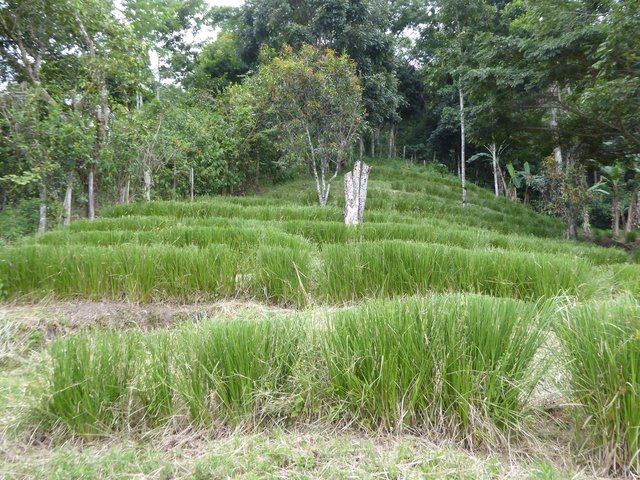
Curved and tiered live hedges [Honduras]
Live hedges are rows of perennial plants, eg. vetiver grass (Vetiveria zizanioides) or izote (Yucca sp.), with dense growth and deep roots, planted on terraced curves in order to control erosion and preserve water. The plant can be used as medicine or fodder (vetiver) or food (izote flower).
- Compiler: Helen Gambon
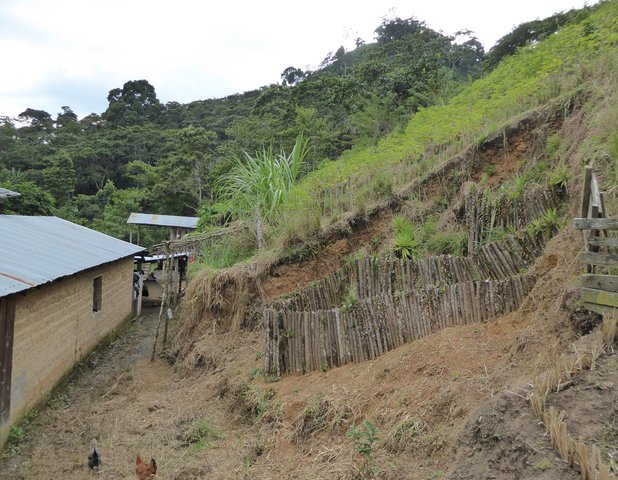
V shaped catchment fence using Izote (Yucca sp.) [Honduras]
V shaped catchment fences are used to stabilize gullies and prevent soil sediments from being removed by surface rain water runoff. It consists of planting izote (Yucca sp.) to create a V shaped fence around a gully.
- Compiler: Helen Gambon
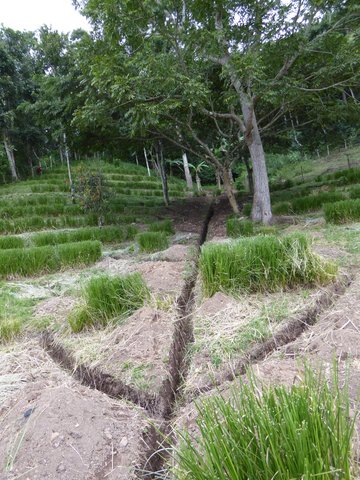
Fascine drainage [Honduras]
Fascine drains are used to drain excess water from elevated lands that might affect plots of land or houses below. They help prevent landslides and gully formation.
- Compiler: Helen Gambon
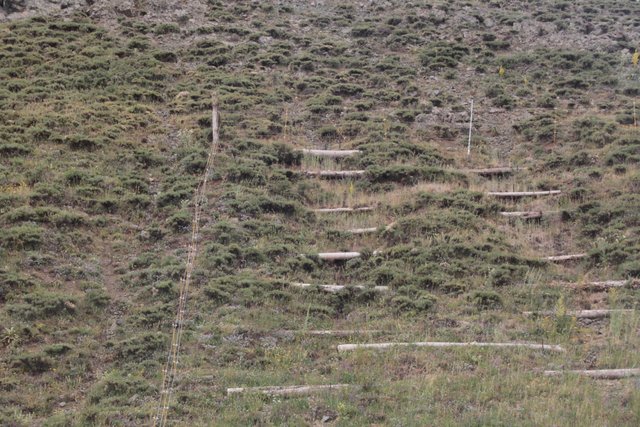
Slope erosion control using wooden pile walls [Armenia]
Small horizontal wooden structures and terraces on eroded slopes built to mitigate sheet or rill erosion and slow down water run-off. The technology is easy to apply and efficient to mitigate erosion processes of the upper soil layer and to stop small rock falls.
- Compiler: Hanns Kirchmeir
2. Description of the SLM Approach
2.1 Short description of the Approach
Bioengineering includes a series of techniques based on the use of live vegetation to protect slopes and embankments from erosion and landslides. Bioengineering works are applied according to comprehensive risk assessment; they are multipurpose as a whole, have a low cost of consdtruction and maintenance cost,they enhance the capacities of families and communities to mitigate disaster hazards and they strengthen health and food safety and strengthen community organizations.
2.2 Detailed description of the Approach
Detailed description of the Approach:
To minimize the impact of hazards and, thus, to minimize risk, the Honduran/ Swiss Red Cross uses miocroprojects to implement specific mitigation measures in the communities it operates. Green Infrastructure, a series of techniques based on living vegetation to prevent erosion and landslides in slopes and embankments, play an important part in these are bioengineering works. Living aaplants are planted in the embankments to reinforce the soil with roots and/or folliage, thus facilitating draining and creating barriers to retain sediment.
As a whole, bioengineering works are multipurpose and require involve low construction and maintenance costs. Thus, low-income, vulnerable families can to adapt the Technology; these works also strengthen the capacities of families and communities to prevent or reduce disaster hazards and promote health and food safety.
Even though bioengineering techniques are implemented through technical assistance provided by the the project's team, it is not a complicated process and the plants used are generally available in the site, thus, these measures are easily replicated.
Sites considered critical and which are very vulnerable to landslides are identified through a comprehensive risk assessment involving participative process that is carried out by a multidisciplinary technical team. Community workshops and home visits are used to raise awareness among the beneficiaries on the existing hazards, and beneficiaries receive training on bioengineering works, soil conservation and climate change. Beneficiaries and technicians carry out field visits to sites deemed once in critical condition but that are now stable. This allows beneficiaries to get acquainted with the techniques used and they also benefit from the experience of the person pioneering the bioengineering work.
The techniques and materials used are identified together with each beneficiary or, when addressing issues referred to protecting community infrastructure, with Local Emergency Committies, Health Committees and Water management Boards. Beneficiaries and community organizations execute bioengineering works together with the technical support provided by the Honduran/Swiss Red Cross. In some cases, the Red Cross also provides materials or transportation for the latter. In most cases, stabilized slopes and embankments are then transformed into sustainable production areas, such as agroecological family orchards or medicinal gardens. Thus, beneficiaries can diversify their food and generate income selling their surplus.
People participate actively in identifying, developing and building bioengineering works, and the high level of adoption of the technology gives evidence of the level of interest and awareness achieved through sensitization and training. Thus, participative processes of implementation, executed under the principle of learning by doing and action-training, lead to specifically reduce local hazards and to generate sustainable learning processes enabling the replication of activities and maiontenance tasks performed by the community.
2.3 Photos of the Approach
2.5 Country/ region/ locations where the Approach has been applied
Country:
Honduras
Region/ State/ Province:
Departament of Olancho
Further specification of location:
Municipalities of Catacamas, Dulce Nombre de Culmí and San Esteban
Map
×2.6 Dates of initiation and termination of the Approach
Indicate year of initiation:
2011
2.7 Type of Approach
- project/ programme based
2.8 Main aims/ objectives of the Approach
To minimize the effects of natural hazards by implementing improved mechanisms addressing these at the community and municipal levels. The impact of hazards and risks is reduced by implementing specific mitigation measures and this empowers vulnerable populations by allowing them to replicate these activities.
2.9 Conditions enabling or hindering implementation of the Technology/ Technologies applied under the Approach
institutional setting
- enabling
Local Emergency Committees (CODEL) implement bioengineering works to protect community infrastructure (schools, health centers, water infrastructure, evacuation routes) and in most cases they help to implement bioengineering works at the household level.
collaboration/ coordination of actors
- enabling
Multiple stakeholder approach and working through alliances facilitate working with different community organizations. This provides improved protection for important community infrastructurre such as schools, health units and water systems.
legal framework (land tenure, land and water use rights)
- enabling
Works can only be executed in land belonging to land users
- hindering
Works can only be executed in land belonging to land users. Thus, implementation is limited in some cases.
knowledge about SLM, access to technical support
- enabling
Training on risk management, sustainable land management and climate change as well as the support provided by the technical team helped implementing bioengineering works.
3. Participation and roles of stakeholders involved
3.1 Stakeholders involved in the Approach and their roles
- local land users/ local communities
Beneficiaries living in houses threatened by landslide hazards (critical sites)
Stakeholders participate in risk assessment and identifying critical sites.
They implement the measures in their land plots with help from CODEL and technical support from Honduran/ Swiss Red Cross
- community-based organizations
Local Emergency Committees (CODEL), Health Committees, Water Management Boards
CODEL committees implement bioengineering works to protect community infrastructure, coordinating with Health Committees and Water Management Committees, the general population, and help to stabilize houses found in critical sites.
- NGO
Honduran/ Swiss Red Cross
Identify critical sites through risk assessment, sensitize and train CODELs and the population, provide technical and material support as needed.
3.2 Involvement of local land users/ local communities in the different phases of the Approach
| Involvement of local land users/ local communities | Specify who was involved and describe activities | |
|---|---|---|
| initiation/ motivation | passive | Disseminate maps depicting risks, provide training to households and the community, as well as community workshops led by Honduran/ Swiss Red Cross. A model work is implemented for the community so its people can get to know the different techniques and benefits derived from bioengineering. |
| planning | interactive | During the planning stage, the project's contribution as well as the counterpart from the community is determined. Also, technologies and materials used for the works are stated. |
| implementation | interactive | Beneficiaries and local emergency committees implement bioengineering works, while Honduran/ Red Cross provides technical and material support. |
| monitoring/ evaluation | self-mobilization | Land users monitor and perform maintenance tasks on mitigation structures. The project provides the required technical support. |
3.3 Flow chart (if available)
Description:
Participative development process to stabilize slopes with bioengineering works in critical sites.
Author:
Carmen Paguada, Honduran/ Swiss Red Cross
3.4 Decision-making on the selection of SLM Technology/ Technologies
Specify who decided on the selection of the Technology/ Technologies to be implemented:
- mainly SLM specialists, following consultation with land users
Specify on what basis decisions were made:
- evaluation of well-documented SLM knowledge (evidence-based decision-making)
- research findings
- personal experience and opinions (undocumented)
4. Technical support, capacity building, and knowledge management
4.1 Capacity building/ training
Was training provided to land users/ other stakeholders?
Yes
Specify who was trained:
- land users
- Local Emergency Committees
Form of training:
- farmer-to-farmer
- demonstration areas
- public meetings
Form of training:
- Community assembly and individuals
Subjects covered:
- Bioengineering works
- Soil Conservation
- Climate Change
4.2 Advisory service
Do land users have access to an advisory service?
Yes
Specify whether advisory service is provided:
- on land users' fields
4.3 Institution strengthening (organizational development)
Have institutions been established or strengthened through the Approach?
- yes, greatly
Specify the level(s) at which institutions have been strengthened or established:
- local
Describe institution, roles and responsibilities, members, etc.
Local Emergency Committees (CODEL) are part of the National System for Risk Management of Honduras. CODEL links communities with the national system through its higher level, the Municipal Emergency Committee. Candidates to CODEL must be accepted and approved by the community and included in the process to enhance local capacities for specific functions.
Specify type of support:
- capacity building/ training
- equipment
Give further details:
Information on the structure, role and operation of CODEL in the community. CODEL members are trained to carry out all the steps involved in risk management (prevention, preparation, response and rehabilitation).
4.4 Monitoring and evaluation
Is monitoring and evaluation part of the Approach?
Yes
If yes, is this documentation intended to be used for monitoring and evaluation?
No
4.5 Research
Was research part of the Approach?
Yes
Specify topics:
- ecology
- Management of Disaster Hazards
5. Financing and external material support
5.1 Annual budget for the SLM component of the Approach
Indicate the annual budget for the SLM component of the Approach in US$:
38000.00
If precise annual budget is not known, indicate range:
- 10,000-100,000
Comments (e.g. main sources of funding/ major donors):
This amount covers costs of material and support/ transportation as well as training in bioengineering and house visits. It does not include the salaries of the technical team from Honduran/ Swiss Red Cross, since their area of work includes the full range of activities related to risk management. Local technicians are paid by Swiss Red Cross.
5.2 Financial/ material support provided to land users
Did land users receive financial/ material support for implementing the Technology/ Technologies?
Yes
If yes, specify type(s) of support, conditions, and provider(s):
Material Support (plants and tools) or transpòrtation of material
5.3 Subsidies for specific inputs (including labour)
- equipment
| Specify which inputs were subsidised | To which extent | Specify subsidies |
|---|---|---|
| tools | fully financed | |
- agricultural
| Specify which inputs were subsidised | To which extent | Specify subsidies |
|---|---|---|
| plantas | partly financed | |
- other
| Other (specify) | To which extent | Specify subsidies |
|---|---|---|
| Traslado de material | partly financed |
If labour by land users was a substantial input, was it:
- voluntary
5.4 Credit
Was credit provided under the Approach for SLM activities?
No
5.5 Other incentives or instruments
Were other incentives or instruments used to promote implementation of SLM Technologies?
No
6. Impact analysis and concluding statements
6.1 Impacts of the Approach
Did the Approach empower local land users, improve stakeholder participation?
- No
- Yes, little
- Yes, moderately
- Yes, greatly
Land users are very motivated and get involved of their own accord.
Did the Approach enable evidence-based decision-making?
- No
- Yes, little
- Yes, moderately
- Yes, greatly
Observing the demonstration works convinced many people to implement the measures in their own homes.
Did the Approach help land users to implement and maintain SLM Technologies?
- No
- Yes, little
- Yes, moderately
- Yes, greatly
No bioengineering works to stabilize slopes were implemented before the project.
Did the Approach improve knowledge and capacities of land users to implement SLM?
- No
- Yes, little
- Yes, moderately
- Yes, greatly
If necessary, explain improvements. If not, provide reasons.
Did the Approach improve knowledge and capacities of other stakeholders?
- No
- Yes, little
- Yes, moderately
- Yes, greatly
The approach includes linking CODEL with municipal government and municipal emergency committees. Sensitization workshops were provided to authorities and technicians in municipalities and the budget for RHR was increased in municipal development plans.
Did the Approach build/ strengthen institutions, collaboration between stakeholders?
- No
- Yes, little
- Yes, moderately
- Yes, greatly
The approach includes linking CODEL committees with municipalities and Municipal Emergency Committees (CODEM). Further, by providing support to land users, CODEL committees managed to increase their visibility and acknowledgement to other stakeholders.
Did the Approach mitigate conflicts?
- No
- Yes, little
- Yes, moderately
- Yes, greatly
In isolated cases, the approach had a positive effect on conflicts among neighbors caused by bad land management (damage to neighbor's properties).
Did the Approach improve gender equality and empower women and girls?
- No
- Yes, little
- Yes, moderately
- Yes, greatly
Maintenance is performed by women. They manage medicinal gardens and family orchards. Thus, they perform jobs previously done only by men, thus giving women new roles in their family. Also, they feel empowered by training and by receiving knowledge and because they manage the medicinal gardens and family orchards.
Did the Approach encourage young people/ the next generation of land users to engage in SLM?
- No
- Yes, little
- Yes, moderately
- Yes, greatly
If necessary, explain improvements. If not, provide reasons.
El enfoque no aborda la temática de tenencia de la tierra.
Did the Approach lead to improved food security/ improved nutrition?
- No
- Yes, little
- Yes, moderately
- Yes, greatly
The agroecological approach promotes the combination of bioengineering works with plants, fruit trees, vegetables and medicinal plants.
Did the Approach improve access to markets?
- No
- Yes, little
- Yes, moderately
- Yes, greatly
Though the approach does not aim at improving market access, it is significant to note that there is actually a small improvement in this regard. An indirect effect of bioengineering works is increase and diversication of production. Also, the surplus from family gardens is sold.
Did the Approach improve the capacity of the land users to adapt to climate changes/ extremes and mitigate climate related disasters?
- No
- Yes, little
- Yes, moderately
- Yes, greatly
If necessary, explain improvements. If not, provide reasons.
Did the Approach lead to employment, income opportunities?
- No
- Yes, little
- Yes, moderately
- Yes, greatly
The families sell their surplus from family orchards.
6.2 Main motivation of land users to implement SLM
- increased production
- reduced risk of disasters
- environmental consciousness
- enhanced SLM knowledge and skills
- aesthetic improvement
6.3 Sustainability of Approach activities
Can the land users sustain what has been implemented through the Approach (without external support)?
- yes
If yes, describe how:
A cooperative process was used to implement bioengineering works. This followed the principles of learning by doing and action-training. Land users felt prepared and motivated to maintain works implemented and some have been trained to build new bioengineering works. The materials used are available on site and they regenerate easily.
6.4 Strengths/ advantages of the Approach
| Strengths/ advantages/ opportunities in the land user’s view |
|---|
| Cooperative work has improved in the community. |
| Bioengineering works are multipurpose, in contrast to grey works; bioengineering does not only reduce risk but also recovers productive spaces and economic oportunities, lead to improved SLM understanding and help diversify nutrition and improve good health (by growing medicinal plants, reducig growth of vectors) |
| Cleaning the land and plots have tangible benefits: not only are they aesthetically pleasing, but bioengineering works have a positive impact on human health as well as individual and community property. Also, they reduce damages. |
| The safety of homes has been increased. |
| Strengths/ advantages/ opportunities in the compiler’s or other key resource person’s view |
|---|
| These measures require little input and are easy to replicate with material found in the site and these are easy to grow back. |
| Bioengineering measures are adapted to local climate and extremes. |
6.5 Weaknesses/ disadvantages of the Approach and ways of overcoming them
| Weaknesses/ disadvantages/ risks in the compiler’s or other key resource person’s view | How can they be overcome? |
|---|---|
| A waiting period is needed to be able to see the protection provided by bioengineering. | |
| Without constant maintenance, bioengineering loses its capacity to provide protection and conservation. | Constant maintenance |
7. References and links
7.1 Methods/ sources of information
- field visits, field surveys
3
- interviews with land users
5
- interviews with SLM specialists/ experts
2
- compilation from reports and other existing documentation
2
7.2 References to available publications
Title, author, year, ISBN:
Respuestas locales y desafíos globales: Reducción de riesgos desde la comunidad. Sistematización de los proyectos desarrollados del 2005 al 2014 en seis municipios de los departamentos de Olancho, Valle y Choluteca, Honduras. Cruz Roja Suiza, 2016
Available from where? Costs?
info@redcross.ch (gratis)
Links and modules
Expand all Collapse allLinks

Curved and tiered live hedges [Honduras]
Live hedges are rows of perennial plants, eg. vetiver grass (Vetiveria zizanioides) or izote (Yucca sp.), with dense growth and deep roots, planted on terraced curves in order to control erosion and preserve water. The plant can be used as medicine or fodder (vetiver) or food (izote flower).
- Compiler: Helen Gambon

V shaped catchment fence using Izote (Yucca sp.) [Honduras]
V shaped catchment fences are used to stabilize gullies and prevent soil sediments from being removed by surface rain water runoff. It consists of planting izote (Yucca sp.) to create a V shaped fence around a gully.
- Compiler: Helen Gambon

Fascine drainage [Honduras]
Fascine drains are used to drain excess water from elevated lands that might affect plots of land or houses below. They help prevent landslides and gully formation.
- Compiler: Helen Gambon

Slope erosion control using wooden pile walls [Armenia]
Small horizontal wooden structures and terraces on eroded slopes built to mitigate sheet or rill erosion and slow down water run-off. The technology is easy to apply and efficient to mitigate erosion processes of the upper soil layer and to stop small rock falls.
- Compiler: Hanns Kirchmeir
Modules
No modules


